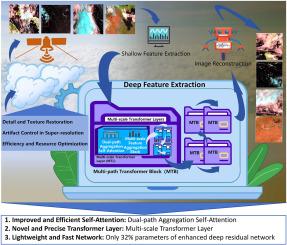Dual-path aggregation transformer network for super-resolution with images occlusions and variability
IF 7.5
2区 计算机科学
Q1 AUTOMATION & CONTROL SYSTEMS
Engineering Applications of Artificial Intelligence
Pub Date : 2024-10-31
DOI:10.1016/j.engappai.2024.109535
引用次数: 0
Abstract
While Transformer-based approaches have recently achieved notable success in super-resolution, their extensive computational requirements impede widespread practical adoption. High-resolution meteorological satellite cloud imagery is essential for weather analysis and forecasting. Enhancing image resolution through super-resolution techniques facilitates the accurate identification and localization of geographic features by meteorological systems. However, current super-resolution methods fail to restore the intricacies of cloud formations and complex regions fully. This research introduces a novel dual-path aggregation Transformer network (DPAT) tailored to enhance the super-resolution of meteorological satellite cloud images. The DPAT network adeptly captures cloud imagery's subtle details and textures, effectively addressing occlusions and the variability inherent in satellite imagery. It bolsters the model's ability to manage the complex attributes of cloud images through the introduction of the Dual-path Aggregation Self-Attention (DASA) mechanism and the Multi-scale Feature Aggregation Block (MFAB), thereby enhancing performance in processing intricate cloud features. The DASA mechanism synthesizes features across spatial, depth, and channel dimensions via a dual-path approach, thoroughly exploiting feature correlations. The MFAB, designed to supplant the multilayer perceptron, incorporates shift convolution and a multi-scale interaction block to augment feature information, compensating for the deficiency in local information absorption due to fixed receptive fields. Experimental outcomes indicate that DPAT delivers superior super-resolution outcomes. With a parameter count of only 32% of the Enhanced Deep Residual Network (EDSR) or 77% of the Image Restoration using Shift Window Transformer (SwinIR), DPAT matches SwinIR's performance on the satellite cloud dataset. Moreover, DPAT balances accuracy and parameter economy across various datasets. This technology is expected to improve image super-resolution capabilities in multiple fields such as human action recognition and industrial recognition, and indirectly improve the accuracy of image perception tasks.

用于图像遮挡和可变性超分辨率的双路径聚合变换器网络
虽然基于变压器的方法最近在超分辨率方面取得了显著成功,但其庞大的计算需求阻碍了其广泛的实际应用。高分辨率气象卫星云图对于天气分析和预报至关重要。通过超分辨率技术提高图像分辨率有助于气象系统准确识别和定位地理特征。然而,目前的超分辨率方法无法完全还原错综复杂的云层和复杂区域。本研究介绍了一种新颖的双路径聚合变压器网络(DPAT),旨在增强气象卫星云图的超分辨率。DPAT 网络能够巧妙地捕捉云图像的微妙细节和纹理,有效地解决遮挡和卫星图像固有的多变性问题。它通过引入双路径聚合自注意(DASA)机制和多尺度特征聚合块(MFAB),增强了模型管理云图像复杂属性的能力,从而提高了处理复杂云特征的性能。DASA 机制通过双路径方法合成跨空间、深度和信道维度的特征,充分利用特征相关性。MFAB 是为取代多层感知器而设计的,它结合了移位卷积和多尺度交互块来增强特征信息,弥补了固定感受野导致的局部信息吸收不足。实验结果表明,DPAT 能提供卓越的超分辨率结果。DPAT 的参数数量仅为增强型深度残差网络(EDSR)的 32%,或使用移位窗变换器进行图像复原(SwinIR)的 77%,在卫星云数据集上与 SwinIR 的性能不相上下。此外,DPAT 还能在各种数据集上平衡精度和参数经济性。这项技术有望在人类动作识别和工业识别等多个领域提高图像超分辨率能力,并间接提高图像感知任务的准确性。
本文章由计算机程序翻译,如有差异,请以英文原文为准。
求助全文
约1分钟内获得全文
求助全文
来源期刊

Engineering Applications of Artificial Intelligence
工程技术-工程:电子与电气
CiteScore
9.60
自引率
10.00%
发文量
505
审稿时长
68 days
期刊介绍:
Artificial Intelligence (AI) is pivotal in driving the fourth industrial revolution, witnessing remarkable advancements across various machine learning methodologies. AI techniques have become indispensable tools for practicing engineers, enabling them to tackle previously insurmountable challenges. Engineering Applications of Artificial Intelligence serves as a global platform for the swift dissemination of research elucidating the practical application of AI methods across all engineering disciplines. Submitted papers are expected to present novel aspects of AI utilized in real-world engineering applications, validated using publicly available datasets to ensure the replicability of research outcomes. Join us in exploring the transformative potential of AI in engineering.
 求助内容:
求助内容: 应助结果提醒方式:
应助结果提醒方式:


